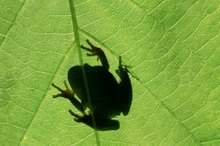How to Take Care of a Baby Painted Turtle
Painted turtles are semi-aquatic pets, meaning they live both in the water and on land, explains Aquaworld Aquarium 3. If you are considering a baby painted turtle as a pet, remember that it will grow to as long as 10 inches, and you need to provide your turtle with a home with ample room to accommodate it as it gets bigger. This is not the pet for you if you are looking for something low maintenance; turtles need quite a bit of hands-on care. In return, your turtle will reward you with up to 25 years of companionship.
Prepare a place for your turtle to live. According to GrizzlyRun, your turtle needs a pool of water at least twice as deep as it is tall 4. Also, the pool should be at least three times as long and wide as your turtle's length. Your turtle needs a soil and gravel resting place away from the water, and it would appreciate decorations such as plants to give him places to hide and feel secure. A 15- to 30-gallon aquarium should fit your turtle, depending on how big it is.
Portable Basketball Goal Sand Vs. Water
Learn More
Add appropriate heat and light sources. Amphibian Care suggests using both UVB-producing fluorescent and household lightbulbs. Turtles require UVB rays in order to keep their shells hard. Look for a bulb that produces at least 5 percent UVB radiation. The basking place out of the water should be kept between 90 and 100 degrees; Amphibian Care recommends placing a 50-watt lightbulb six inches from the surface of the gravel and soil to accomplish this. Use an aquarium water heater to keep the water heated to 75 to 80 degrees Fahrenheit.
Feed your baby painted turtle daily. Offer live foods, such as brine shrimp, guppies and brown or black worms. Some baby turtles will accept protein sources that are not alive, such as pieces of lean beef, fish and worms. Also offer leafy vegetables and some fruits. Add calcium and vitamins to the food, recommends the California Turtle and Tortoise Club 2. Remove any excess food after your turtle is done eating.
How to Get Rid of Frog Noises at Night
Learn More
Siphon the water regularly to keep the tank clean, suggests Amphibian Care. Change most of the water in the tank every 1 to 3 weeks. In between, siphon out any waste from the bottom of the tank and replace the water. GrizzlyRun suggests also using an internal or external canister filter to keep the water clean between manual cleanings.
Watch your turtle carefully for illnesses. The California Turtle and Tortoise Club recommends watching for signs of fungus, injuries, swollen eyes and a soft shell 2.
Tips
Buy commercial turtle food if you desire, but GrizzlyRun suggests that these not comprise more than 25 percent of your turtle's diet.
Avoid undergravel filters for your baby painted turtle. These simply pull waste down into the gravel and allow harmful ammonia, bacteria, nitrates and nitrites to build up.
Warnings
Always wash your hands after handling your turtle and never allow young children to handle your pet without close supervision. Turtles can carry diseases, including salmonella.
Related Articles
References
Writer Bio
Michelle Kulas worked in the health-care field for 10 years, serving as a certified nurses' assistant, dental assistant and dental insurance billing coordinator. Her areas of expertise include health and dental topics, parenting, nutrition, homeschooling and travel.








